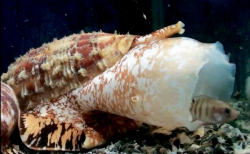Specialized insulin in the venom of cone snails: a new drug for diabetes?
Cone snail venoms comprise hundreds of biologically active components, the majority of which are small, disulfide-rich peptides known as conopeptides. Conopeptides have attracted therapeutic interest especially as analgesics. However, their chemical synthesis is complicated by multiple disulfide bonds and additional post-translational modifications, which often result in conopeptide misfolding and aggregation. Emerging evidence suggests that venom glandular cells have evolved mechanisms for the proper folding of conopeptides. Delineation of these mechanisms will likely improve current chemical synthesis approaches and facilitate the pharmaceutical production of conopeptides. In this context, the EU-funded CONBIOS project focused on oxidative folding of conopeptides. To identify enzymes involved in this process the consortium performed large-scale sequencing of venom gland transcriptomes from different cone snail species belonging to a variety of lineages. A molecular platform for conopeptide expression Large-scale analysis of venom gland transcriptomes led to the discovery of a previously unknown gene family of protein disulfide isomerases (PDIs) called conotoxin-specific PDI (csPDI). PDIs are critical for protein folding in the endoplasmic reticulum and the discovery of the csPDIs suggested that these play an important role for the folding of conopeptides in the venom gland of cone snails. Researchers observed that csPDIs have undergone accelerated evolution with high mutation rates in regions known to be important for catalytic activity and substrate binding. When tested csPDIs greatly improved the folding rates of conopeptides, suggesting that they could be used to improve the production of these toxins. The CONBIOS consortium used this knowledge to design a bacterial expression system for conotoxin co-expression with csPDIs and other folding enzymes. ‘This platform allowed us to efficiently produce conopeptides for functional, pharmacological and structural studies’ explains project co-ordinator Prof. Lars Ellgaard, University of Copenhagen. The discovery of insulin in cone snail venom Similar to mammalian insulin, which regulates sugar homeostasis, insulins in molluscs are produced in endocrine cells associated with the gastrointestinal tract and neuroendocrine cells and play an important role in energy metabolism. Intriguingly, the CONBIOS research efforts led to the discovery of an additional insulin molecule present in the venom of the fish-hunting cone snail Conus geographus. The venom insulin shared high sequence similarity with fish insulin, the prey of this cone snail species. ‘This was the first report of the presence of insulin in venom and we hypothesised that this specialised insulin is utilised to facilitate prey capture by inducing a hypoglycemic shock’ mentions Dr. Safavi-Hemami. The consortium conducted experiments, which confirmed the hypothesis that venom insulins evolved for prey capture. This unexpected finding triggered the transcriptome analysis of 20 additional cone snail species to find insulin widely distributed in nearly all of them. However, only fish-hunting snails contained venom insulin of similarity to human and fish. This insulin is released into the water where it is taken up by fish to activate the fish insulin receptor, causing rapid depletion of blood glucose and impairing swimming of the prey. The discovery of insulin in cone snail venom opens up a window for its therapeutic exploitation. Researchers identified unique structural features of the venom insulin from C. geographus that suggested it could serve as an insulin analogue for the treatment of diabetes. Indeed the X-ray structure of C. geographus venom insulin showed that it is highly similar to human insulin, and functional testing revealed that it is active at the human insulin receptor. This novel family of insulins is currently being investigated for the design of novel drugs for the treatment of diabetes. Apart from discovering this natural source of insulin, the conopeptide expression system generated during CONBIOS could be applied to other disulfide-rich peptides of biological and pharmacological importance.







